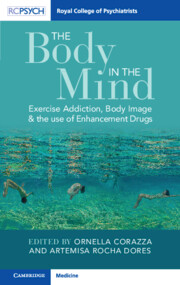Book contents
- The Body in the Mind
- The Body in the Mind
- Copyright page
- Dedication
- Contents
- Figures
- Tables
- Boxes
- Contributors
- Acknowledgements
- Introduction
- Section 1 From Exercise to Addiction: An Introduction to the Phenomenon
- Chapter 1 Exercise Addiction
- Chapter 2 From Exercise to Addiction
- Chapter 3 The COVID-19 Pandemic
- Chapter 4 Excessive Exercise and Image- and Performance-Enhancing Drug Use Among Sports Disciplines, and the Role of Mind–Body Training
- Chapter 5 The Ideal of the Perfect Body
- Chapter 6 Exercise, Fitspiration, and the Role of Social Media
- Chapter 7 Eating Disorders and Over-Exercise
- Chapter 8 Exercise and the Use of Image- and Performance-Enhancing Drugs within the Gym Environment
- Chapter 9 Bodybuilding, Exercise, and Image- and Performance-Enhancing Drug Use during the COVID-19 Pandemic
- Chapter 10 How to Treat Exercise Addiction
- Section 2 Reaching the Extreme with Exercise: A Collection of Clinical Case Studies
- Section 3 Exploring the Motivations Behind Exercise Addiction
- Index
- References
Chapter 9 - Bodybuilding, Exercise, and Image- and Performance-Enhancing Drug Use during the COVID-19 Pandemic
from Section 1 - From Exercise to Addiction: An Introduction to the Phenomenon
Published online by Cambridge University Press: 30 March 2023
- The Body in the Mind
- The Body in the Mind
- Copyright page
- Dedication
- Contents
- Figures
- Tables
- Boxes
- Contributors
- Acknowledgements
- Introduction
- Section 1 From Exercise to Addiction: An Introduction to the Phenomenon
- Chapter 1 Exercise Addiction
- Chapter 2 From Exercise to Addiction
- Chapter 3 The COVID-19 Pandemic
- Chapter 4 Excessive Exercise and Image- and Performance-Enhancing Drug Use Among Sports Disciplines, and the Role of Mind–Body Training
- Chapter 5 The Ideal of the Perfect Body
- Chapter 6 Exercise, Fitspiration, and the Role of Social Media
- Chapter 7 Eating Disorders and Over-Exercise
- Chapter 8 Exercise and the Use of Image- and Performance-Enhancing Drugs within the Gym Environment
- Chapter 9 Bodybuilding, Exercise, and Image- and Performance-Enhancing Drug Use during the COVID-19 Pandemic
- Chapter 10 How to Treat Exercise Addiction
- Section 2 Reaching the Extreme with Exercise: A Collection of Clinical Case Studies
- Section 3 Exploring the Motivations Behind Exercise Addiction
- Index
- References
Summary
The COVID-19 pandemic and the worldwide government-enforced restrictions that were implemented to curb the spread of the virus affected many aspects of life, including exercise and fitness. This chapter draws upon netnographic research conducted early in the pandemic, which involved monitoring four open-access fitness forums to observe the real-time impact of the pandemic on fitness behaviours. Thematic content analyses were used to evaluate 115 forum threads. A significant impact on individuals’ body goals and motivation to use image- and performance-enhancing drugs (IPEDs) was observed, with many forum posters being unable to maintain their pre-pandemic exercise routines. Key thematic results included physical limitations to fitness, fitness routine adjustment and innovation, availability of and access to IPEDs, changes in motivation for using IPEDs, and misinformation about the relationship between IPED use and COVID-19. The chapter discusses these themes in the context of exercise and fitness-related behaviours during the initial months of the pandemic.
- Type
- Chapter
- Information
- The Body in the MindExercise Addiction, Body Image and the Use of Enhancement Drugs, pp. 137 - 144Publisher: Cambridge University PressPrint publication year: 2023



